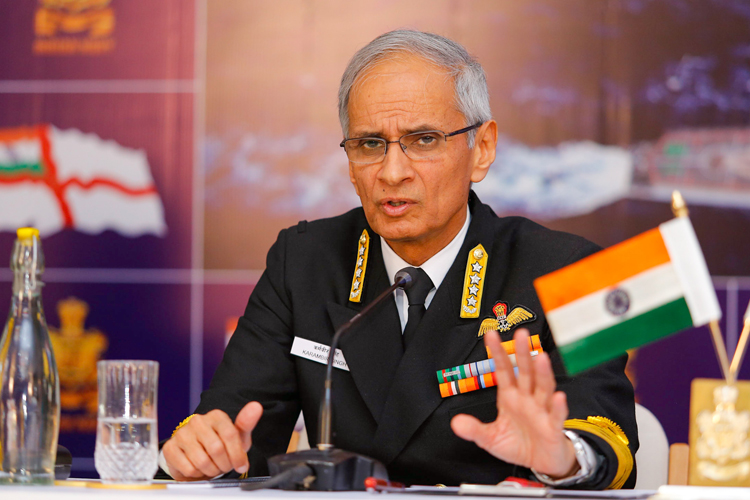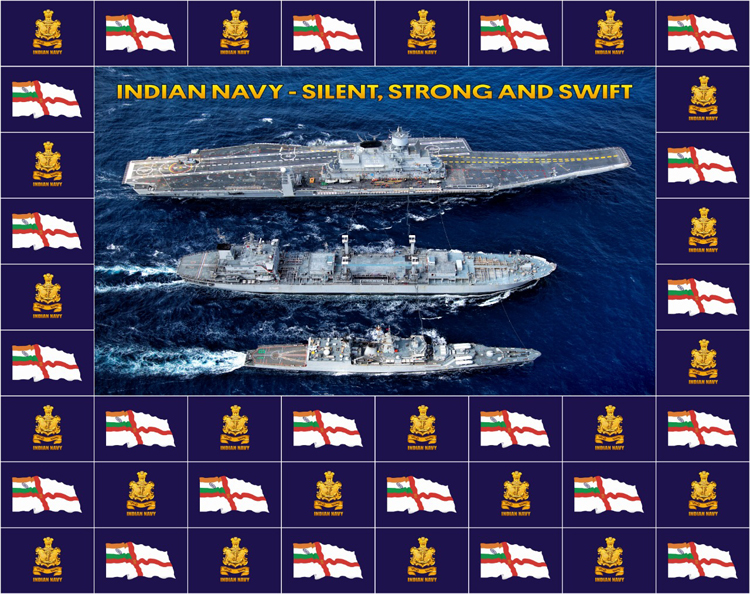- Prime Minister Narendra Modi inaugurates Aero India 2023 in Bengaluru; Releases Commemorative Stamp
- Defence Secretary meets delegations from Saudi Arabia, USA and Oman on the sidelines of Aero India 2023
- Foreign Ministers of 32 countries to attend Aero India 2023
- Embraer showcases the C-390 Millennium at Aero India 2023
Budget crunch forces Indian Navy to cut down on its plan for a 200-ship Navy by 2027
Force levels to be downsized to 175 in 15-year Maritime Capability Perspective Plan; Navy Chief puts up a brave front

A festering Budget crunch has forced the Indian Navy to cut down on its plan to grow into a 200-ship Navy by 2027, the Chief of Naval Staff Admiral Karambir Singh acknowledged at a press conference in New Delhi on December 3 ahead of Navy Day.
Changes are being made in the Maritime Capability Perspective Plan (MCPP) for the period 2012-2027 to bring down projected force levels from 200 warships to 175 in order to re-align the Navy's warship acquisition with shrinking Budgets.
Naval procurement programmes and induction of warships, submarines and aircraft are carried out in accordance with the 15-year MCPP, which provides for a build-up to 200 ships by 2027 from the current force level of 130. The MCPP reflects capabilities and assets required against threat assessments. It is based on an assurance of a rise in Budgets. But reduced availability of funds is leaving the Navy high and dry, forcing it to downsize plans.
The Admiralty is putting up a brave front but the Indian Navy expansion plans have been severely compromised by declining budgets. Sharply illustrating the crunch is the 23,156.43 Crore allocation of Capital funds for the Navy for 2019-20, which falls short of meeting even committed liabilities for the fiscal by about 6,000 Crore. This leaves no funds for new contracts, including the $2.4 Billion deal for 24 MH-60R multi-role naval helicopters which is ready for signature
"I have directed staff to maximize ships in terms of effects rather than (get into) bean counting," Admiral Karambir Singh said, responding to a question by this reporter.
Vice-Chief of Naval Staff Vice-Admiral G Ashok Kumar - who was also present at the press conference along with the principal staff officers at Navy Headquarters - added that the projected force levels by the year 2027 have been reduced from 200 to 175. Admiral Singh described even this diminished number as "optimistic".
"The Navy's share of the Defence Budget has declined from 18 per cent in 2012 to 13 per cent in 2019-20," he acknowledged.
The overall financial allocation of 45,368.11 Crore for the Indian Navy in the current fiscal has fallen to a level below what it was in 2014. In percentage terms, it has dropped to 13 per cent of the Defence Budget from a level of 18 per cent in 2012

Ironically, the focus of Budgetary allocations has moved away from the priority of a naval build-up at a time when China is rapidly ramping up naval presence in India's maritime backyard.
Putting up a brave face, the Navy Chief said his force would make do with what is available through prioritisation of acquisitions and rationalisation of expenditure to cut spending.
Insisting that he was "not too disheartened" by the reduced numbers, Admiral Singh said 50 ships & submarines and 36 aircraft are on order, and Acceptance of Necessity (AON) has been obtained to initiate procurement of 41 more ships, 6 P8I Long Range Maritime Reconnaissance(LRMR) aircraft and 34 helicopters. Depleting force levels will be an unspecified number of warships and aircraft in use scheduled for decommissioning by 2027 on reaching the end of their service life.
The Indian Navy is learnt to be seeking an increase in annual funding to at least 16 per cent of the Defence Budget, which translates to about 10,000 Crore. A budgetary review sought by the Ministry of Defence in November following strong representations by all three services has not resulted in any relief so far
"What is more important is what you pack into a ship in terms of effects - more modern and lethal sensors and weapons," he said, indicating that the Navy will focus on ensuring more capability per platform in the face of shrinking numbers, promising "maximum bang for the buck".
Illustrating the resolve to make do with less, the Navy Chief made a reference to reduction in the additional acquisition of the major surveillance and combat platform, the P8I LRMR aircraft from 10 to 6. "If I don't get the numbers, then we will use other means like networking (assets), combination of satellites, white shipping agreements, HALE UAVs, IMAC networking," he said.
On paring down another critical and long-delayed requirement for 12 Mine Counter-Measure Vessels (MCMVs), Admiral Singh said, "We're looking at a combination of minesweepers and unmanned solutions."
But he dug his heels on the third concurrently operational aircraft carrier, insisting that there is no room for compromise. "We require 3 carriers to ensure that 2 Carrier Battle Groups are available for dispersed deployment at all times," the Navy Chief asserted. The first indigenous aircraft carrier, Vikrant, is due for operational induction in 2022, he said. At the moment, India has only one aircraft carrier, INS Vikramaditya, which was acquired from Russia.
The overall shortfall in Capital funds for all three services is estimated to be about 20,000 Crore for the current fiscal. In terms of allocation of funds for Defence as a percentage of the GDP, the current level of 1.56 is the lowest since the 1962 military debacle
The Admiralty is putting up a brave front but the Indian Navy expansion plans have been severely compromised by declining budgets. Sharply illustrating the crunch is the 23,156.43 Crore allocation of Capital funds for the Navy for 2019-20, which falls short of meeting even committed liabilities for the fiscal by about 6,000 Crore. This leaves no funds for new contracts, including the $2.4 Billion deal for 24 MH-60R multi-role naval helicopters which is ready for signature.
The overall financial allocation of 45,368.11 Crore for the Indian Navy in the current fiscal has fallen to a level below what it was in 2014. In percentage terms, it has dropped to 13 per cent of the Defence Budget from a level of 18 per cent in 2012.
The Indian Navy is learnt to be seeking an increase in annual funding to at least 16 per cent of the Defence Budget, which translates to about 10,000 Crore. A budgetary review sought by the Ministry of Defence in November following strong representations by all three services has not resulted in any relief so far.
The overall shortfall in Capital funds for all three services is estimated to be about 20,000 Crore for the current fiscal. In terms of allocation of funds for Defence as a percentage of the GDP, the current level of 1.56 is the lowest since the 1962 military debacle.





